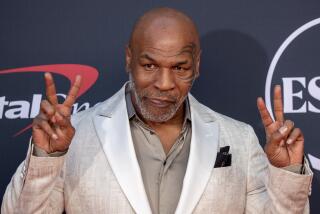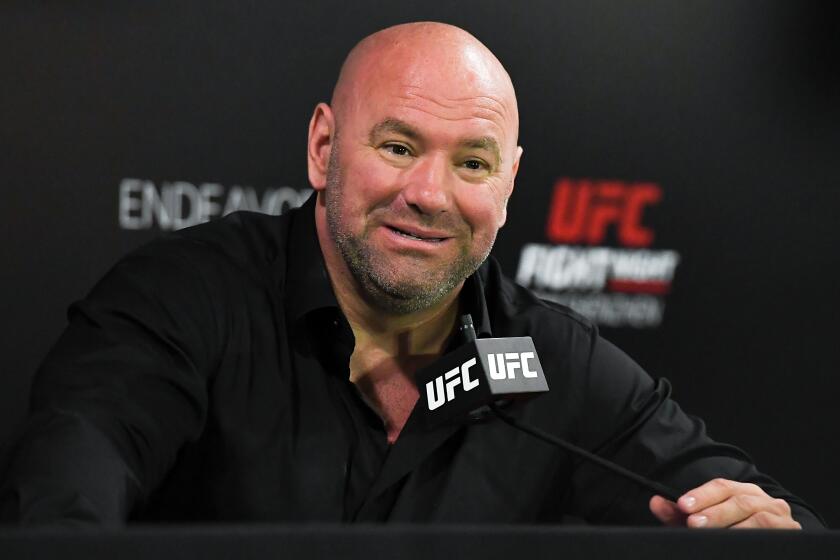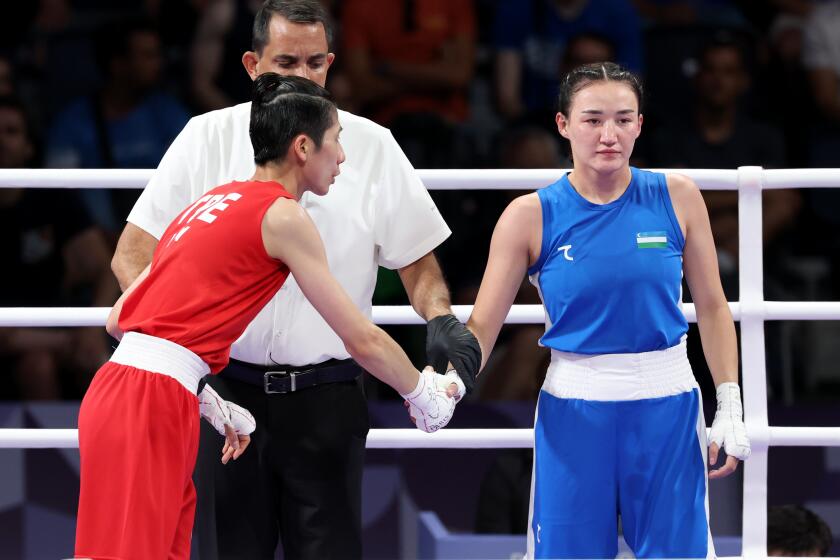Tyson Deserves Respect, Even If It Is Only as a Fighter, Not a Person
Mike Tyson whines about earning only $30 million in his last fight. He complains about trying to raise a family--what family?--on $65 million, the amount he has made in three fights over the last seven months. He is rude in news conferences, pouts and snarls and curses in public, and is generally noncommunicative with the public.
After all this, he cries about not getting any respect.
No kidding.
But he’s right.
Tyson’s boorish behavior, outrageous demands, connection to controversial promoter Don King, and three-year prison term for a rape conviction have all clouded and soiled his public image.
But none of that should diminish his accomplishments as a boxer, which are phenomenal.
In 1960, Floyd Patterson became an international celebrity when he won back the heavyweight title from Ingemar Johansson. In 1974, Muhammad Ali was given the same treatment when he regained the heavyweight crown by beating George Foreman. Foreman himself earned the respect of boxing fans by coming back after a 10-year absence from boxing and eventually regained the heavyweight crown.
And in recent months, Magic Johnson has earned praise all over the globe for being able to successfully step back onto the basketball court after a 4 1/2-year retirement.
Yet none of them were ever quite the same as they had been before.
Which makes Tyson’s performance all the more amazing.
Tyson terrorized the heavyweight division almost from the day he turned professional in 1985. A style built on raw power and intimidation left one opponent after another crumpled and beaten. Tyson has knocked out 38 of his 45 opponents, a percentage of 84%, which ranks him third on the all-time heavyweight list among the champions, behind only Foreman and Rocky Marciano.
In 1991, Tyson’s career was put on hold when he went on trial and then to prison. Other athletes who have staged memorable comebacks were able to prepare at their leisure. Even Ali, banned from boxing because of his refusal to serve in the armed forces during the Vietnam war, was able to bob and weave with sparring partners during his exile to keep the rust off. Johnson continued to play basketball all over the world while sitting out more than four NBA seasons, keeping his passes, his hook shot and his court sense sharp.
This is not to say that Tyson should have been afforded special treatment in prison. That’s not the point.
The point is that he stepped back into the gym with his body in superb shape, but his boxing skills having lain dormant for three years. And by the time Tyson got into the ring against an actual opponent--some fairly question the use of the word opponent to describe Peter McNeeley--it had been four years and two months since his last fight, a decision over Donovan “Razor” Ruddock.
Critics discounted the McNeeley fight, which is fair. Nothing could be judged by Tyson’s 89-second demolition of McNeeley last August, five months after Tyson’s release from prison. It was McNeeley, not Tyson, who looked as though he didn’t belong in the ring.
In December, Tyson knocked out Buster Mathis Jr. in three rounds. That was a better test, and Tyson admittedly failed part of it, missing an unusually high number of punches. He looked like a man who hadn’t been in the ring in a long time, a boxer with more question marks than exclamation points in his punches.
Then came Tyson’s fight against World Boxing Council heavyweight champion Frank Bruno earlier this month, and all the questions were answered. True, nobody is going to confuse Bruno with any of the great heavyweight champions, recent or distant. But he was a credible opponent who outweighed Tyson by 28 pounds and had an advantage of 3 1/2 inches in height and 11 inches in reach.
But Tyson waded through all of that to show he is truly back. The footwork was steady, the stamina intact, the punches were sharp and devastating. And 50 seconds into the third round, Bruno was gone.
It would take the best of boxing experts with keen eyes to view a tape of the old Tyson and the new Tyson and find anything more than the smallest technical differences.
At 29, he again reigns supreme in the heavyweight division. His has been a highly impressive comeback by any yardstick, with no serious threats on the horizon.
George Foreman? Too old and too slow.
Evander Holyfield? Unable to withstand the punishment.
Riddick Bowe? He would figure to be Tyson’s toughest opponent. But there have been serious questions raised about Bowe’s dedication to conditioning and his overall skill level.
Against Holyfield last year, Bowe, five years younger, 23 pounds heavier and three inches taller, was nearly knocked out in the sixth round before coming back to win in the eighth. Tyson will give Bowe problems Holyfield never dreamed of.
Will Tyson ever lose again?
Certainly, probably to someone who is now 18 or 19, in a fight that will probably happen in about six or seven years.
Tyson’s accomplishments already rank him with the greatest of the heavyweights. For that and his comeback, he deserves respect as a fighter, whatever anyone thinks of him as a person.
*
The comeback of Rafael Ruelas will begin and the comeback of Gabriel Ruelas will continue in San Antonio on April 30.
The brothers will fight on a USA network telecast against opponents to be determined. Ruelas, who lost the World Boxing Council super-featherweight title to Azumah Nelson last December, is on track to get another crack at the title. Nelson will defend against James Leija on June 1 at Boulder Station in Las Vegas. Ruelas, who has already beaten Leija, will get a shot at the winner.
Rafael, a former International Boxing Federation lightweight champion, is trying to bounce back after consecutive losses to Oscar De La Hoya and George Scott.
More to Read
Go beyond the scoreboard
Get the latest on L.A.'s teams in the daily Sports Report newsletter.
You may occasionally receive promotional content from the Los Angeles Times.










